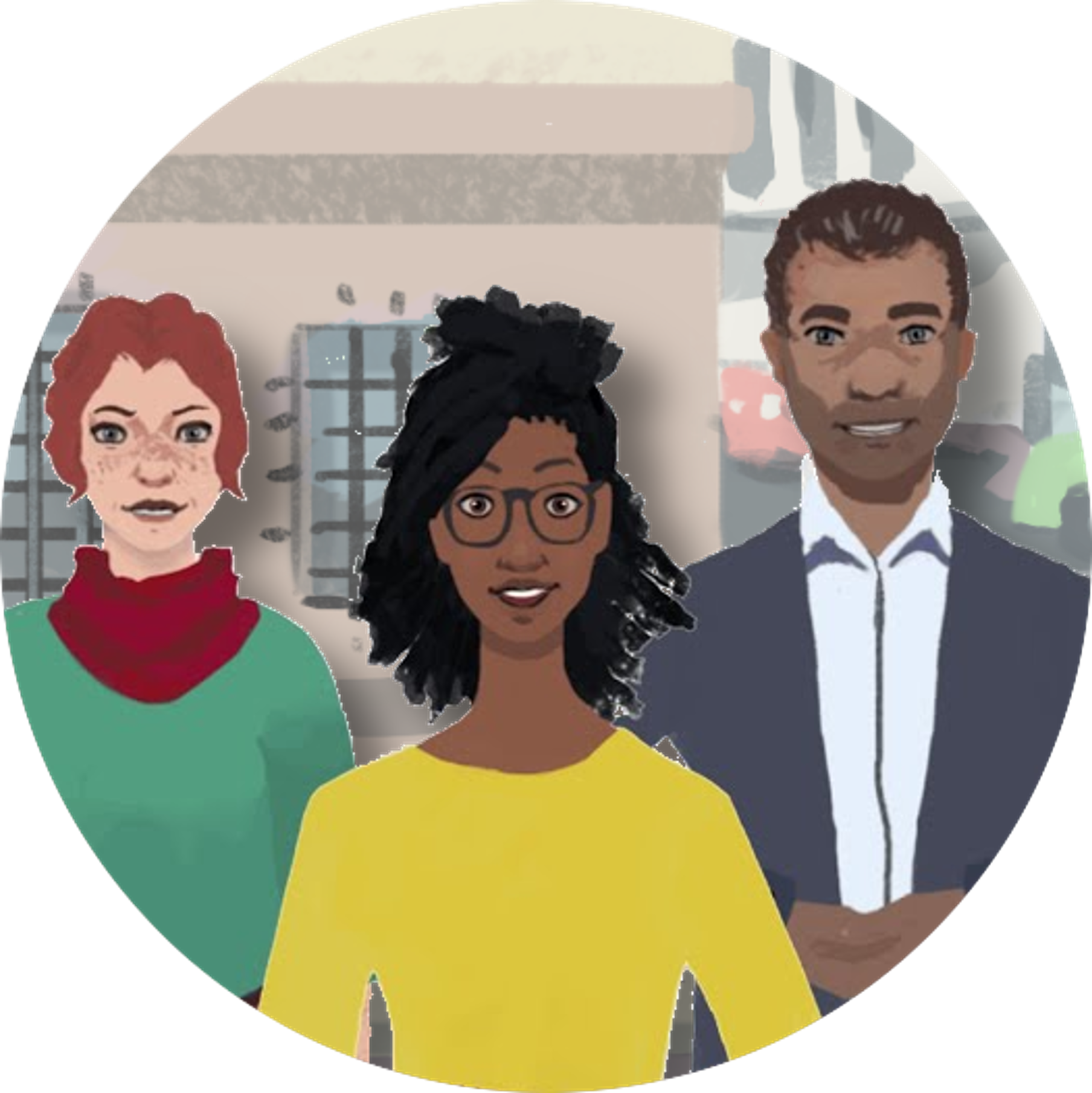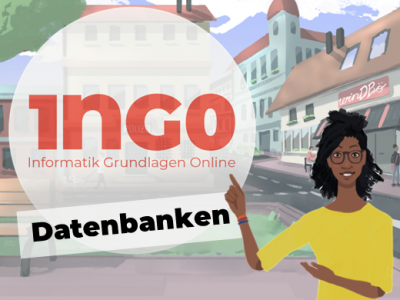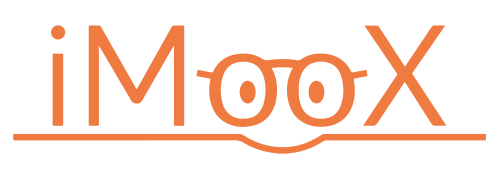Immerse yourself in the world of databases
Course start: 6. de març 2023
Immerse yourself in the world of databases
Claudia Steinberger, Nina Lobnig
Scientific classification:
Course start: 6. de març 2023
Immerse yourself in the world of databases
Claudia Steinberger, Nina Lobnig
-
Scope: 8 units
-
Effort: 6 hours/week
-
Current participants: 268
-
Licence: CC BY 4.0
-
Course start: 6. de març 2023
-
Course end: 11. de febrer 2024
-
Current status: Ongoing course
-
Available languages:
Trailer
Course details
General information about the course
In this course you'll find all kinds of stuff about databases - from modeling with UML to relation schemas and their quality up to SQL. Our content, such as videos, PDFs and more, is designed for everyone: pupils, students and anyone else who is interested.
Dive into the world of databases, learn content through stories! Animated characters explain content and its use in concrete problem situations and take place in a police department and a local bakery and are always database-related. The content spans the entire life cycle of a criminal case database, which is then also used by two police officers to solve current criminal cases, carry out administrative work, and much more.
The conceptual and logical design steps of this database are accompanied and the query language SQL is learned in an application oriented way. The idea behind this course is to get away from a typical teaching setting with recorded lectures, towards the active design and application of databases. Videos are therefore underlaid with H5P elements to increase interactivity and consolidate knowledge right away. The associated tasks are also designed in an exciting way and embedded in stories. Help our two inspectors apply what you've already heard and show what you've got!
Additional note: The tasks for SQL queries are also included in aDBenture (adbenture.aau.at) and can be played directly on the website, the link is attached to the corresponding tasks. However, this is only one possibility, as the tasks can also be tried out and solved with a local database instance.
Course content
What can you expect in the course? What content will be covered?
You can get a brief overview in the video above.
Structure of the course:
The MOOC is divided into several lessons - that's 8 adventurous steps into the world of relational databases:
Lesson 1: Overview of the MOOC's goals, content, and working methods.
Lesson 2: Introduction to the world of databases
Lesson 3: Domain analysis and conceptual design (semantic data model)
Lesson 4: Design of a relational database (transformation to the relational model)
Lesson 5: Introduction to SQL and creating a database with SQL
Lesson 6: Simple queries with SQL
Lesson 7: More complex queries with SQL (joins, grouping, aggregation)
Lesson 8: Complex queries with SQL II (subqueries)
Note: The above learning time per lesson is estimated and results if all topics and in-depth examples (tasks) are worked through completely in the lessons. With appropriate prior knowledge, this can be significantly shortened. It is also possible to only take the course from lesson 5 or 6 (SQL). In this case, however, no certificate of attendance can be provided.
Further note: This course will take place for the first time in summer 2023 and serves to test the developed materials. We are happy to receive feedback. The experiences will be evaluated and the course will be further developed and expanded in the following. Therefore, this course also has an end date (January 2024) and will later be replaced by a new, revised version.
Learning goals
- Know the characteristics, architecture and data models of database systems.
- Be able to list phases of database development and briefly describe the necessary steps
- Be able to design a database conceptually (using UML class diagrams)
- Being able to derive a relation model from the database design
- Know the features of SQL, its command categories and the advantage of standardization
- Be able to set up a database on a relational database system (using SQL)
- Be able to query information from individual tables using SQL
- Be able to query information by joining multiple tables, group and aggregate data (calculate max, min, average)
- Be able to create simple and correlated subqueries (subqueries)
Prerequisites
No special prior knowledge is required for this course. This excludes ordinary computer skills, as well as related software (including downloading and installing software) and using web applications.
Course schedule
Each lesson starts by outlining the key content that will be covered in the lesson and questions that can be answered after the lesson is complete. If we suggest an exercise environment in a lesson, there is also detailed information about it before things get started. Depending on the scope, a lesson consists of one or more topics.
In this MOOC, we follow a particularly applied learning approach (in cooperation with police department 42). Therefore, topics usually start with a practical question, which is intended as a challenge and should be able to be solved after working through the topic. If the necessary competencies are already available due to previous experience, this will become clear already at this point.
For each topic, we offer learning objects that convey basic knowledge about a topic (what I should know about the topic) or show the application of this basic knowledge by means of examples (application examples) and also tasks for applying what has been learned. These can be short videos (with characters from our police department 42), texts or audios. The order of the learning objects is technically sequential, but can be consumed as needed.
Each lesson concludes with a lesson quiz. 75% of the required points are necessary for the positive completion of the lesson (and the certificate of participation at the end).
Certificate
For actively participating in the course you will receive an automatic certificate which includes your username, the course name as well as the completed lessons. We want to point out that this certificate merely confirms that the user answered at least 75% of the self-assessment questions correctly.
Licence
This work is licensed under Creative Commons - 4.0 International (CC BY 4.0) University of Klagenfurt.
Course Instructor
Claudia Steinberger, Nina Lobnig
The main authors are Claudia Steinberger and Nina Lobnig, who were actively supported by their colleagues.
If you have any comments or questions, feel free to use the forums in the course or write us a short e-mail (also welcome to send us ideas for improvement): 1ng0@aau.at

Sam Winter, Lara Fischer and Amar Kovač
Our fictional characters Sam Winter, Lara Fischer and Amar Kovač will guide you through the course, presenting the content both in theory and in practice as well as illustrating it with examples.
Sam Winter (pictured in the middle) is an expert in databases and introduces the various topics, explains all the important details and also demonstrates the content using examples. She often brings examples from her favorite bakery, which she supports in the implementation of a new database, as well as from the police department, with whom she also cooperates.
Lara Fischer (on the left) and Amar Kovač (on the right) are two police officers who exchange ideas with expert Sam. They apply the introduced knowledge in their daily work.
Contributors to the conception and production of the MOOC and its content (all coming from the University of Klagenfurt, listed alphabetically):
- Nicole Burgstaller
- Nina Lobnig
- Michael Morak
- Claudia Steinberger
- Claudia van der Rijst
- Anna-Sophie Wallner
- Aron Wedam
- Markus Wieser
- Andreas Bollin (didactic consulation)
The characters, backgrounds and objects were specially drawn and animated. The people involved in this:
- Jan Jancik (consulting, rigging, intro and outro)
- Stefan Pesendorfer (consulting as well as drawings)
- Wolfgang Neipl
- Nessa Heschmat
Questions or comments?
Feel free to send us an email at: 1ng0@aau.at
(Attention: The mail address contains two numbers).
Partners

University of Klagenfurt



